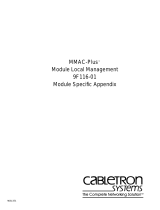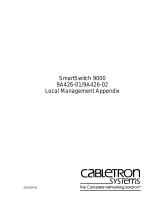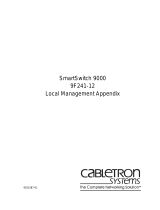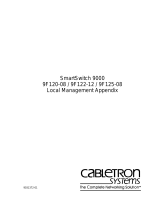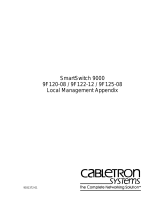Page is loading ...

903number
SmartSwitch 9000
9A426-01 ATM Module
User’s Guide


i
Notice
Notice
Cabletron Systems reserves the right to make changes in specifications and other information
contained in this document without prior notice. The reader should in all cases consult Cabletron
Systems to determine whether any such changes have been made.
The hardware, firmware, or software described in this manual is subject to change without notice.
IN NO EVENT SHALL CABLETRON SYSTEMS BE LIABLE FOR ANY INCIDENTAL, INDIRECT,
SPECIAL, OR CONSEQUENTIAL DAMAGES WHATSOEVER (INCLUDING BUT NOT LIMITED
TO LOST PROFITS) ARISING OUT OF OR RELATED TO THIS MANUAL OR THE INFORMATION
CONTAINED IN IT, EVEN IF CABLETRON SYSTEMS HAS BEEN ADVISED OF, KNOWN, OR
SHOULD HAVE KNOWN, THE POSSIBILITY OF SUCH DAMAGES.
© Copyright February 1998 by:
Cabletron Systems, Inc.
35 Industrial Way
Rochester, NH 03867-5005
All Rights Reserved
Printed in the United States of America
Order Number: 9032055-02
LANVIEW
is a registered trademark and
SmartSwitch
is a trademark of Cabletron Systems, Inc.
CompuServe
is a registered trademark of CompuServe, Inc.
i960 microprocessor
is a registered trademark of Intel Corp.

Notice
ii
FCC Notice
This device complies with Part 15 of the FCC rules. Operation is subject to the following two
conditions: (1) this device may not cause harmful interference, and (2) this device must accept any
interference received, including interference that may cause undesired operation.
NOTE:
This equipment has been tested and found to comply with the limits for a Class A digital
device, pursuant to Part 15 of the FCC rules. These limits are designed to provide reasonable
protection against harmful interference when the equipment is operated in a commercial environment.
This equipment uses, generates, and can radiate radio frequency energy and if not installed in
accordance with the operator’s manual, may cause harmful interference to radio communications.
Operation of this equipment in a residential area is likely to cause interference in which case the user
will be required to correct the interference at his own expense.
WARNING:
Changes or modifications made to this device which are not expressly approved by the
party responsible for compliance could void the user’s authority to operate the equipment.
VCCI Notice
This equipment is in the 1st Class Category (information equipment to be used in commercial and/or
industrial areas) and conforms to the standards set by the Voluntary Control Council for Interference
by Information Technology Equipment (VCCI) aimed at preventing radio interference in commercial
and/or industrial areas.
Consequently, when used in a residential area or in an adjacent area thereto, radio interference may be
caused to radios and TV receivers, etc.
Read the instructions for correct handling.

iii
Notice
DOC Notice
This digital apparatus does not exceed the Class A limits for radio noise emissions from digital
apparatus set out in the Radio Interference Regulations of the Canadian Department of
Communications.
Le présent appareil numérique n’émet pas de bruits radioélectriques dépassant les limites applicables
aux appareils numériques de la class A prescrites dans le Règlement sur le brouillage radioélectrique
édicté par le ministère des Communications du Canada.

Notice
iv
DECLARATION OF CONFORMITY
Application of Council Directive(s):
89/336/EEC
73/23/EEC
Manufacturer’s Name:
Cabletron Systems, Inc.
Manufacturer’s Address:
35 Industrial Way
PO Box 5005
Rochester, NH 03867
European Representative Name:
Mr. J. Solari
European Representative Address:
Cabletron Systems Limited
Nexus House, Newbury Business Park
London Road, Newbury
Berkshire RG13 2PZ, England
Conformance to Directive(s)/Product Standards:
EC Directive 89/336/EEC
EC Directive 73/23/EEC
EN 55022
EN 50082-1
EN 60950
Equipment Type/Environment:
Networking Equipment, for use in a
Commercial or Light
Industrial Environment.
We the undersigned, hereby declare, under our sole responsibility, that the equipment packaged with
this notice conforms to the above directives.
Manufacturer Legal Representative in Europe
Mr. Ronald Fotino Mr. J. Solari
____________________________________________________ ______________________________________________________
Full Name Full Name
Principal Compliance Engineer Managing Director - E.M.E.A.
____________________________________________________ ______________________________________________________
Title Title
Rochester, NH, USA Newbury, Berkshire, England
____________________________________________________ ______________________________________________________
Location Location

v
Contents
Chapter 1 Introduction
Features........................................................................................................................... 1-2
Related Manuals............................................................................................................ 1-6
Getting Help ..................................................................................................................1-6
Chapter 2 Preparing and Installing the
9A426-01 Module
Unpacking the Module................................................................................................. 2-1
The Module’s Physical Layout.................................................................................... 2-2
User-Accessible Components on the Module’s Motherboard................................ 2-3
Installing an APIM in the 9A426-01 Module ..................................................... 2-4
User-Accessible Components on the Module’s Daughterboard............................ 2-9
DIP Switch............................................................................................................. 2-10
Removing the daughterboard from the motherboard.................................... 2-12
Installing the Module into the SmartSwitch 9000 Chassis.................................... 2-16
The Reset Switch ......................................................................................................... 2-18
Chapter 3 Operation
LAN Emulation ............................................................................................................. 3-3
System Management Buses ......................................................................................... 3-3
SMB-1 Bus ............................................................................................................... 3-3
SMB-10 Bus ............................................................................................................. 3-4
System Diagnostic Controller...................................................................................... 3-4
DC/DC Converter ........................................................................................................ 3-4
INB Network Interface Block ...................................................................................... 3-5
FDDI Network Interface Block.................................................................................... 3-5
ATM Network Interface Block .................................................................................... 3-5
SecureFast Virtual Networking................................................................................... 3-6
i960 Core......................................................................................................................... 3-6
Chapter 4 LANVIEW LEDs

Contents
vi
Chapter 5 Specifications
Technical Specifications................................................................................................5-1
CPU ..........................................................................................................................5-1
Memory ...................................................................................................................5-1
Address Table Size .................................................................................................5-1
Power.......................................................................................................................5-1
Network Interfaces ................................................................................................5-1
Standards.................................................................................................................5-2
Safety...............................................................................................................................5-2
Service.............................................................................................................................5-2
Physical...........................................................................................................................5-3
Dimensions .............................................................................................................5-3
Weight......................................................................................................................5-3
Environment ...........................................................................................................5-3

1-1
Chapter 1
Introduction
The 9A426-01 ATM SmartSwitch Module is a hardware-based switching module
that supports multiple interfaces simultaneously. The module’s interconnecting
interfaces include:
• A front panel ATM interface via a user-installed ATM Port Interface Module
(APIM)
• A fixed interface to the SmartSwitch 9000 Internal Network Bus (INB)
• A user-configurable interface to the SmartSwitch 9000 Flexible Network Bus
(FNB-1 or FNB-2).
Each data packet, regardless of the interface in which the packet enters the
module (ATM, FNB, or INB), is initially converted into a common format known
as a canonical frame. Each canonical frame’s header section contains source and
destination information. All canonical frames are forwarded to the module’s
group of SmartSwitch Application Specific Integrated Circuits (ASICs)
collectively known as the SmartSwitch Core.
The SmartSwitch Core can process data in two modes:
• Traditional Switch - When operating as a traditional switch, the Fast Packet
Switch makes filtering/forwarding decisions based on Destination Address,
with standard IEEE 802.1d learning.
• Secure Fast Switch (SFS) - When operating in SFS mode, all filtering/
forwarding decisions are based on a Destination Address-Source Address pair,
and the associated receive/transmit port.
Canonical frames that enter the 9A426-01 Module via the backplane interface
(FNB or INB) and are destined for the module’s front panel interface(s), are
converted by the module’s ATM Network Interface Block (ANIB) into 53 byte
ATM cells. The ANIB uses a separate set of ASICs to perform hardware-based
packet to cell conversions. This conversion process is an integral part of the
module’s ability to provide high-performance interconnections between legacy
LANs and ATM attached networks.

Introduction
1-2
Conversely, canonical frames destined for the FNB bus on the SmartSwitch 9000
backplane are converted into FDDI packets via the 9A426-01 Module’s FDDI
Network Interface Block (FNIB), and then forwarded onto the FNB.
Canonical frames destined for the INB bus on the SmartSwitch 9000 backplane are
converted into fixed length data packets via the 9A426-01 Module’s INB Network
Interface Block (INB NIB), and then forwarded onto the INB.
Features
Processor
The 9A426-01 Module is equipped with an advanced Intel i960 microprocessor.
This microprocessor provides a platform for all management functions within a
scalable RISC-based architecture.
SmartSwitch Core
The 9A426-01 Module incorporates the SmartSwitch Core, a collection of custom
Application Specific Integrated Circuits (ASICs) designed specifically for high
speed switching. The SmartSwitch ASIC bus is 64 bits wide with a bandwidth of
640 Mbps. Since all frame translation, address lookups, and forwarding decisions
are performed in hardware, the 9A426-01 Module can obtain a throughput
performance of greater than 750K pps.
Management
The 9A426-01 Module has one full implementation of SMT (Version 7.3) and
SNMP for local and remote management. Local management is provided through
the RS-232 COM ports on the SmartSwitch 9000 Environmental Module using a
standard VT-220™ terminal or emulator, or via telnet. Remote management is
achieved through Cabletron’s SPECTRUM or any SNMP-compliant management
tool. Switching statistics of the selected FNB interface include frames filtered,
frames forwarded, and all Spanning Tree Protocol parameters.
Connectivity
The 9A426-01 Module is designed to accept two standard Cabletron ATM Port
Interface Modules (APIMs). However, only one APIM can be active at one time (a
second APIM becomes active whenever the first APIM becomes inactive). Thus,
the second APIM is not necessary, but can be installed if physical layer
redundancy is desired. This redundancy protects against loss of data due to cable
failure, ATM Switch failure or APIM failure. If two APIMs are installed in the
9A426-01 Module, the second APIM does not have to be the same as the first
APIM. For example, you can place an APIM-21 (multimode fiber) in one APIM
port, and an APIM-29 (single mode fiber) in the module’s second APIM port.
Cabletron APIMs are designed to accept a variety of cable types including: single
mode fiber, multimode fiber, twisted-pair, and coaxial.

1-3
Introduction
Redundancy
To ensure the transmission of data from a 9A426-01 Module to an ATM backbone,
the module offers an additional “redundant” front panel port. Redundancy can be
achieved by inserting a second APIM in the module’s front panel APIM port,
connecting cables to that APIM, and enabling the redundancy feature via SNMP
(network management) of the module (you can also disable redundancy via
network management). Only one APIM port on the module can be active at one
time. The inactive port, if occupied, serves as the “redundant APIM”.
The 9A426-01 Module also provides users with a variety of options to monitor
and control redundancy. First, a user can select which port is the “primary” port
and which port is the “redundant” port. This feature allows the user to select a
port with more (or less) bandwidth according to the importance of the network
uplink and the cost of the connection.
A second feature of redundancy on the 9A426-01 Module is the ability to test both
APIM links at any time. This test reassures the user that if one port fails, the other
redundant port (and associated connections) will function properly. This feature
allows the user to correct any cabling errors or deficiencies while in a test status as
opposed to real-time status.
A third feature of redundancy on the 9A426-01 Module is evident when an actual
switch (failover) to the redundant link occurs. At that time, the module will audit
the primary link (at a user-selectable time of day) to determine if that link is once
again able to function. If the primary link is able to function, the module will
switch back to the primary link. The “time of day” option provides users with the
ability to check the primary port’s condition during “off peak hours” to minimize
network disruption.
The process of switching to a redundant link is a multiple step procedure. First,
the module severs its connections to all ELANs. The module then proceeds to find
a redundant link. During the re-establishment of connections, all communications
to ELAN services cease. Once the redundant link is established as the new link, all
of the primary link’s ELAN configuration information and PVC data is “carried
over” to the active link.
For example, if the module’s primary link was connected to ELAN1, and the
primary link became unusable, the module will sever its connection to ELAN1,
immediately switch to the module’s redundant link, and then begin to re-
establish communications with ELAN1 (by making a request to join ELAN1).
Once the join process is completed (connecting to the LES and BUS), data
communications will commence. All connections that map MAC to ATM
information will be flushed. This MAC to ATM table will be re-established the
first time the legacy LAN systems attempts to communicate across the ATM.

Introduction
1-4
Although the actual physical switch (from primary to redundant link) performed
by the module is nearly immediate, the amount of time required to re-establish
full communications varies according to factors associated with LANE 1.0
protocols and the performance/feature set of the user’s LANE services, but is
typically less than one minute.
Management Information Base (MIB) Support
The 9A426-01 Module provides MIB support including:
• IETF AToM MIB,
• IETF FDDI MIB,
• IETF Bridge MIB, and
• a host of Cabletron Enterprise MIBs
LANVIEW LEDs
The 9A426-01 Module uses LANVIEW – Cabletron Systems built-in visual
diagnostic and status monitoring system. With LANVIEW LEDs, you can quickly
identify the device, port, and physical layer status at a glance.
If the module’s redundant link and primary link are two different physical ATM
switches, the module will receive a new ATM address.
NOTE

1-5
Introduction
Figure 1-1. The 9A426-01 Module
SMB CPU
A
T
M
1
A
T
M
2
FNB
INB
9A426-01
ATM

Introduction
1-6
Related Manuals
The manuals listed below should be used to supplement the procedures and
technical data contained in this manual.
SmartSwitch 9000 Installation Guide
SmartSwitch 9000 9C300-1 Environmental Module User’s Guide
SmartSwitch 9000 9C214-1 AC Power Supply User’s Guide
INB Terminator Modules Installation Guide
SmartSwitch 9000 Local Management User’s Guide
SmartSwitch 9000 9A426-01/9A426-02 Module-Specific Local Management
Appendix
Getting Help
If you need additional support related to this device, or if you have any questions,
comments, or suggestions concerning this manual, contact the Cabletron Systems
Global Call Center:
Phone (603) 332-9400
Internet mail suppor[email protected]
FTP ctron.com (134.141.197.25)
Login
anonymous
Password
your email address
BBS (603) 335-3358
Modem setting 8N1: 8 data bits, No parity, 1 stop bit
For additional information about Cabletron Systems or our products,
visit our World Wide Web site:
http://www.cabletron.com/
For technical support, select
Service and Support
.
For a complete list of supported MIBs, refer to the release notes provided in the
9A426-01 Module package.
NOTE

1-7
Introduction
Before calling the Cabletron Systems Global Call Center, have the following
information ready:
• Your Cabletron Systems service contract number
• A description of the failure
• A description of any action(s) already taken to resolve the problem (e.g.,
changing mode switches, rebooting the unit, etc.)
• The serial and revision numbers of all involved Cabletron Systems products in
the network
• A description of your network environment (layout, cable type, etc.)
• Network load and frame size at the time of trouble (if known)
• The device history (i.e., have you returned the device before, is this a recurring
problem, etc.)
• Any previous Return Material Authorization (RMA) numbers

Introduction
1-8

2-1
Chapter 2
Preparing and Installing the
9A426-01 Module
This chapter describes the physical layout of the 9A426-01 Module and explains
how to prepare and install the module in a SmartSwitch 9000 chassis.
Unpacking the Module
1. Carefully remove the module from the shipping box. (Save the box and
packing materials in the event the module must be reshipped.)
2. Remove the module from the plastic bag. Observe all precautions to prevent
damage from Electrostatic Discharge (ESD).
3. Carefully examine the module, checking for damage. If any damage exists,
DO NOT install the module. Contact Cabletron Systems Technical Support
immediately.
Never expose the module’s components to Electrostatic Discharge: Make sure you
have attached the module’s disposable grounding strap to your wrist and always
place the module on a non-conductive surface.
WARNING

Preparing and Installing the 9A426-01 Module
2-2
The Module’s Physical Layout
The 9A426-01 Module has two major circuit boards on which components are
attached (see Figure 2-1). The module’s base-level circuit board is known as the
motherboard. The module’s second-level circuit board is known as the
daughterboard. The removable daughterboard attaches to the motherboard’s
connectors and standoffs. Both the motherboard and the daughterboard contain
components that are accessible to the user.
Figure 2-1. The 9A426-01 Module’s two major circuit boards
motherboard
daughterboard

2-3
Preparing and Installing the 9A426-01 Module
User-Accessible Components on the Module’s
Motherboard
The user-accessible components on the module’s motherboard include
a Look-Up
Engine, a user-installed ATM Memory Upgrade SRAM SIMM, and a user-
installed
ATM Port Interface Module
(
APIM). See Figure 2-2.
Figure 2-2. User-Accessible Components on the 9A426-01 Module’s motherboard
The User-Accessible Components on the motherboard of a 9A426-01 Module
are positioned in close proximity to one another. Therefore, to attain easier
access for removing a desired component, you may opt to remove an additional
component. For example, you may remove an SRAM SIMM to gain better
access for removing a Look-Up Engine.
NOTE
APIM
Look-Up
Engine
APIM
SRAM
SIMM

Preparing and Installing the 9A426-01 Module
2-4
Look-Up Engine
The 9A426-01 Module is shipped with a look-up engine. The look-up engine is
located at the front section of the module as shown in Figure 2-2. The Look-Up
Engine stores MAC Address/Virtual Channel Pairings.
To increase the capacity of the front panel port’s Look-Up Engine, install the
Look-Up Engine Upgrade Kit (LUE-UGK). Installation instructions are included
in each upgrade kit.
SRAM SIMM
The front panel port on the 9A426-01 Module is equipped with two megabytes of
Static Random Access Memory(SRAM).
To increase the SRAM of the front panel port, install the SRAM SIMM from the
ATM Memory Upgrade Kit (ATM-MEM-UGK) in the port’s corresponding SIMM
socket.
The SRAM SIMM fits into the SIMM socket located at the front section of the
module as shown in Figure 2-2. Installation instructions are included in the
upgrade kit.
APIMs
The preparation of the 9A426-01 Module includes the installation of at least one
ATM Port Interface Module (APIM) in the module’s front panel port (a second
APIM can be installed for redundancy). The module is shipped with no installed
APIMs. You customize the module to your particular need by selecting from a
variety of APIMs, and then installing the selected APIM(s) in the module.
Figure 2-2 shows two APIMs installed in a 9A426-01 Module. Installation
instructions are provided in the following section.
Installing an APIM in the 9A426-01 Module
To install an APIM in the 9A426-01 Module, you must:
• Unpack the APIM.
• Remove the 9A426-01 Module’s ATM-Port Retaining Plate.
• Insert the APIM in the 9A426-01 Module.
• Attach the 9A426-01 Module’s ATM-Port Retaining Plate.
Throughout each of these procedures, you must never expose the module’s
components to Electrostatic Discharge. Make sure you have attached the
module’s disposable grounding strap to your wrist and always place the module
on a non-conductive surface.
/

